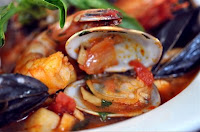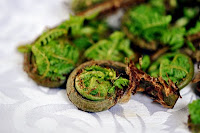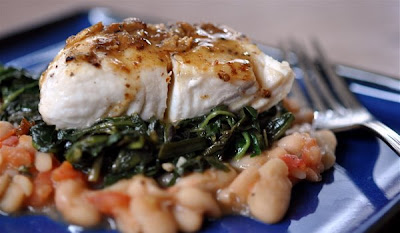 WHAT’S IN A NAME? In our anxiety-prone food culture we tend to get uptight about the smallest lexical tics and demarkations. For instance, is it a Bouillabaisse or a Cioppino? How about Fish Soup—that seems to work pretty well. Italians mostly call dishes like this Zuppa di Pesce—Fish Soup. Occasionally Ciuppin. And sometimes Brodetto… Okay, you get the idea.
WHAT’S IN A NAME? In our anxiety-prone food culture we tend to get uptight about the smallest lexical tics and demarkations. For instance, is it a Bouillabaisse or a Cioppino? How about Fish Soup—that seems to work pretty well. Italians mostly call dishes like this Zuppa di Pesce—Fish Soup. Occasionally Ciuppin. And sometimes Brodetto… Okay, you get the idea.
A Brodetto is a regional Italian variation found along the Adriatic that calls for special inclusion of the scorpionfish, or scorfano. Bouillabaisse is the Provencal word for essentially the same thing. All involve a mixture of both finned fish and shellfish, cooked in a tomato and wine-based stew, with peasant bread for sopping up the rich broth.
Cioppino, legend has it, is a New World invention—the word, that is. Italian immigrants shipping out of San Francisco to fish the Pacific ate Cioppino at sea—the catch of the day plus whatever other ingredients they had on board. The word derives from ciuppin, which translates as “chop”—in other words, chop it all together and make soup.
That’s what I love about Cioppinos and their ilk. When you can get past the regional claims, prejudices, and pronouncements, a Cioppino is merely an efficient way to make use of the odds and ends hanging around in the fridge. But to do it right you still need a variety of fish. Make it with either red wine or white; with spicy peppers or saffron; with fennel or celery. Just make it. You won’t be disappointed.
 Here are my ingredients this time around. Remember that you can use just about anything that swims in the sea, or that filters salt water, as the case may be. Squid add lots of flavor. Just about any firm white-fleshed fish is a good choice; avoid more fragile-fleshed species such as flounder, sole, and thin cuts of cod as well as the dark-fleshed fish (e.g. salmon, mackerel, tuna) that will overpower the stew.
Here are my ingredients this time around. Remember that you can use just about anything that swims in the sea, or that filters salt water, as the case may be. Squid add lots of flavor. Just about any firm white-fleshed fish is a good choice; avoid more fragile-fleshed species such as flounder, sole, and thin cuts of cod as well as the dark-fleshed fish (e.g. salmon, mackerel, tuna) that will overpower the stew.
I used 2 cups of homemade shrimp stock. You can use a cup of clam juice plus a cup of chicken broth, or conventional fish stock. Fish heads are ideal if you can get them; my market was sold out.
2 dozen littleneck clams
2 dozen (or more) mussels
1 lb shrimp, shelled
1 lb bay scallops
1/2 cooked Dungeness crab, broken into leg segments
1 lb rockfish fillets, cut into 3-inch pieces
1-2 cups white wine (or red)
1 28 oz can whole plum tomatoes with liquid
2 cups fish stock (or clam juice, shrimp stock, etc.)
1/4 cup olive oil
2 tbsp tomato paste
4 cloves garlic, minced
2 medium onions (or 1 large), chopped
2 ribs celery, diced
1 carrot, diced
1 bay leaf
1-2 tsp red pepper flakes
1/4 cup fresh parsley, chopped
fresh basil for garnish
good bread
In a heavy pot or Dutch oven saute the onions in olive oil over medium heat for a minute or two, then add the garlic, chopped vegetables, red pepper flakes, and bay leaf. Cook several minutes until veggies are soft, then stir in tomato paste. Cook another minute and pour in wine and let bubble for a couple minutes. Add tomatoes and stock, roughly chopping the whole tomatoes in the pot. Simmer for a least 30 minutes; longer is better. Add the crab legs and simmer another 15 minutes. When you’re ready to serve the stew, add the fin fish first and simmer for a few minutes, then add the shellfish. When the clams and mussels have all opened, stir in the parsley. It’s ready to eat. Serve piping hot with good crusty bread and some chopped basil for garnish.
As written above, this Cioppino will easily serve six, but for larger groups you can add another can of tomatoes, more wine and stock, extra seasoning, and leave the seafood amounts as is. Or, if serving a smaller group you might consider cutting the shrimp and scallops by half. All this seafood can be expensive when paying market prices, so tinker according to your budget and taste. It’s a very forgiving dish.
Like this:
Like Loading...
 SOUNDS LIKE AN Arizona ghost town. In fact, Chickweed Chimichuri is a zesty sauce.
SOUNDS LIKE AN Arizona ghost town. In fact, Chickweed Chimichuri is a zesty sauce. Chimichurri hails from Argentina, where it was invented by an Irishman named Jimmy McCurry fighting for Argentinean independence in the 19th century. The sauce’s name is reputedly a bastardization of his name. Anyway, the traditional way to prepare it is with parsley, vinegar, garlic, oil, and hot pepper.
Chimichurri hails from Argentina, where it was invented by an Irishman named Jimmy McCurry fighting for Argentinean independence in the 19th century. The sauce’s name is reputedly a bastardization of his name. Anyway, the traditional way to prepare it is with parsley, vinegar, garlic, oil, and hot pepper. 1 packed cup chickweed, chopped
1 packed cup chickweed, chopped Mix chimichurri ingredients together in a bowl and refrigerate for an hour or so. Meanwhile make seasoned (i.e. add rice vinegar) sushi rice and cut up a bunch of sushi-grade tuna. Serve a dollop of the raw tuna over a bowl of rice; garnish with the chimichurri. The acidity of the chimichurri immediately begins to act on the tuna, changing the flavor in subtle ways as you eat.
Mix chimichurri ingredients together in a bowl and refrigerate for an hour or so. Meanwhile make seasoned (i.e. add rice vinegar) sushi rice and cut up a bunch of sushi-grade tuna. Serve a dollop of the raw tuna over a bowl of rice; garnish with the chimichurri. The acidity of the chimichurri immediately begins to act on the tuna, changing the flavor in subtle ways as you eat.
































